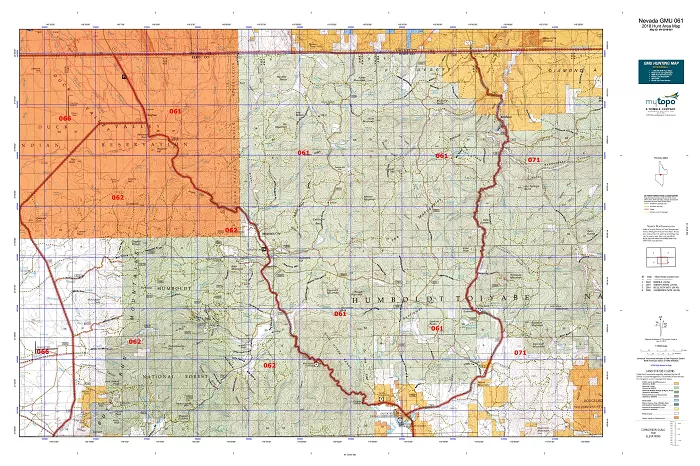Nevada’s diverse landscapes offer a wealth of hunting opportunities, from expansive deserts to lush mountain ranges. To effectively manage wildlife and provide hunters with clear guidelines, the Nevada Department of Wildlife (NDOW) has divided the state into specific hunting units, each with its own regulations and seasons. Understanding the Nevada hunt unit map is essential for both novice and experienced hunters to ensure a successful and lawful hunting experience.
Overview of Nevada’s Hunting Units
Nevada is segmented into numerous hunting units, each identified by a unique number. These units are designed based on geographical features, wildlife populations, and land ownership patterns. The primary purpose of these divisions is to manage wildlife resources sustainably and to distribute hunting pressure evenly across the state.
Each unit may have specific regulations concerning:
- Species Availability: Not all units offer hunting opportunities for every species. For instance, while mule deer might be prevalent in one unit, another might be designated for elk or antelope hunting.
- Season Dates: Hunting seasons can vary between units to align with wildlife migration patterns, breeding seasons, and population management goals.
- Permit Quotas: The number of permits issued for each species within a unit is determined based on population surveys and conservation objectives.
Key Features of the Nevada Hunt Zone Map
1. Game Management Units (GMUs)
Nevada is divided into over 100 GMUs, each with unique geographic boundaries. These units are identified by numbers (e.g., GMU 061, GMU 162) and cover a variety of terrains, from desert valleys to mountain ranges.
2. Species-Specific Zones
Some GMUs are designated for specific species, such as mule deer, elk, or pronghorn. The map provides detailed information on which species can be hunted in each unit.
3. Public and Private Lands
The hunt zone map distinguishes between public and private lands. Public lands, such as those managed by the Bureau of Land Management (BLM) or the U.S. Forest Service, are open to hunting, while private lands require permission from the landowner.
4. Access Points and Roads
The map includes major roads, trails, and access points to help hunters navigate the terrain and reach their desired hunting areas.
Accessing the Nevada Hunt Unit Map
To plan your hunt effectively, it’s crucial to familiarize yourself with the specific unit where you intend to hunt. NDOW provides several resources to assist hunters in this regard:
- Interactive Online Maps: NDOW offers an interactive mapping tool that allows users to view unit boundaries, terrain features, and land ownership details. This tool is invaluable for scouting potential hunting areas and understanding the lay of the land.
- Downloadable PDFs: For those who prefer traditional maps, NDOW provides downloadable PDF maps of each hunting unit. These maps are detailed and can be printed for offline use.
- Mobile Applications: Several third-party apps, compatible with smartphones and GPS devices, offer detailed maps of Nevada’s hunting units. These apps often include features like offline access, waypoint marking, and real-time tracking.
Regulations and Guidelines
Each hunting unit in Nevada operates under specific regulations to ensure sustainable wildlife management and hunter safety. Key considerations include:
- Licensing Requirements: All hunters aged 12 and older must possess a valid Nevada hunting license. Additionally, hunters born after January 1, 1960, are required to complete a hunter education course.
- Species-Specific Tags: Beyond the general hunting license, hunters must obtain species-specific tags for big game animals like deer, elk, and antelope. These tags are often limited and distributed through a lottery system.
- Weapon Restrictions: Different units may have specific regulations regarding the types of weapons permitted, such as archery equipment, muzzleloaders, or rifles. It’s essential to verify the allowed weapon types for your chosen unit and season.
- Season Dates: Each unit has designated hunting seasons for various species. These dates are established based on factors like breeding seasons and population management needs.
Planning Your Hunt
To ensure a successful hunting experience in Nevada:
- Identify Your Desired Species: Determine which game you intend to hunt and research which units offer opportunities for that species.
- Review Unit Regulations: Once you’ve selected a unit, thoroughly review its specific regulations, season dates, and permit requirements.
- Obtain Necessary Licenses and Tags: Apply for the required licenses and tags well in advance, as some permits are distributed through lotteries with application deadlines.
- Scout the Area: Utilize maps and, if possible, visit the unit beforehand to familiarize yourself with the terrain, access points, and potential hunting spots.
- Stay Informed: Regularly check NDOW’s website or contact their offices for any updates or changes to regulations and season dates.
Conclusion
Understanding and utilizing the Nevada hunt unit map is a fundamental aspect of responsible hunting in the state. By familiarizing yourself with unit boundaries, regulations, and resources, you can ensure a safe, ethical, and successful hunting experience. Always prioritize conservation principles and respect the land to preserve Nevada’s rich hunting traditions for future generations.

